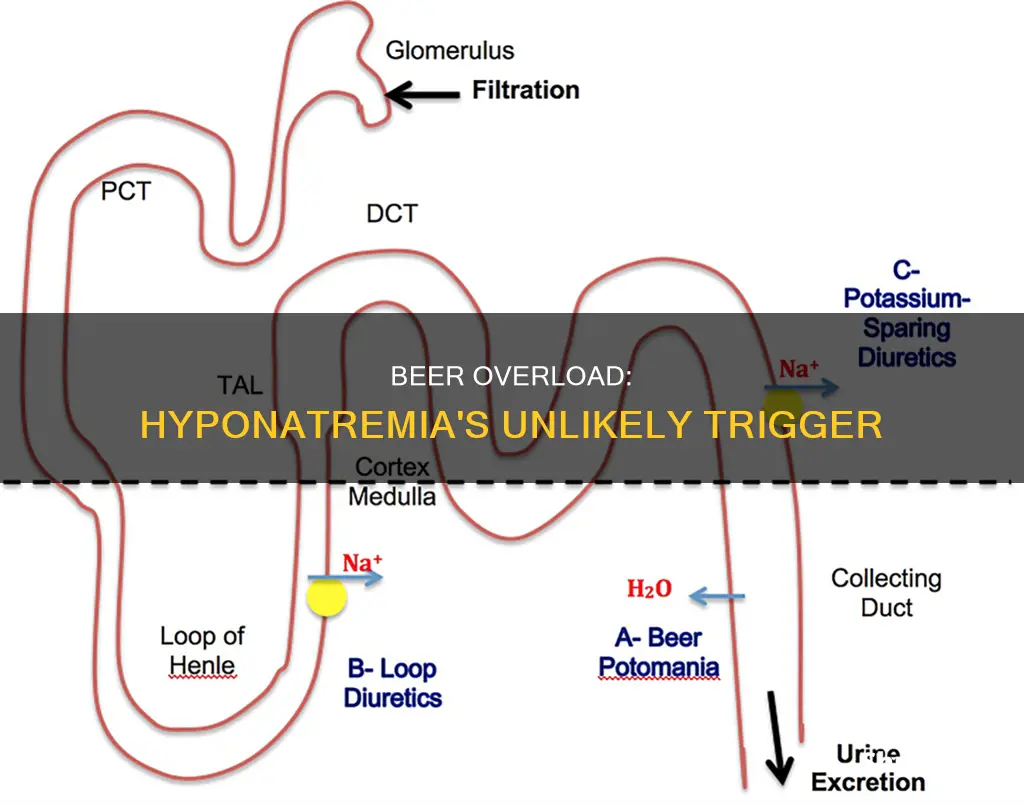
Drinking too much beer can indeed cause hyponatremia, a condition known as beer potomania. Beer potomania is a syndrome of severe hyponatremia, or low sodium levels in the blood, resulting from excessive beer consumption in conjunction with poor dietary intake. This condition was first reported in 1972 and typically affects individuals who consume large quantities of beer while also having a low intake of sodium and protein-rich foods. The low solute content of beer, coupled with the suppressive effect of alcohol on protein breakdown, leads to reduced solute delivery to the kidneys. This results in a dilution of sodium levels in the body, causing symptoms such as fatigue, dizziness, and muscular weakness. Left untreated, beer potomania can lead to serious neurological complications and even death. Therefore, early detection and careful management are crucial to prevent potential life-threatening consequences.
| Characteristics | Values |
|---|---|
| What is it? | A condition called hyponatremia, which is a lack of sodium in the blood. |
| What causes it? | Excessive beer consumption, especially when coupled with poor dietary solute intake. |
| What are the symptoms? | Fatigue, dizziness, muscular weakness, lethargy, irritability, restlessness, muscle cramps, loss of consciousness, coma, seizures, confusion, etc. |
| Treatment | Depends on the symptoms and the severity of the condition. Treatment may involve being admitted to a hospital intensive care unit, not being given food or drink for 24 hours, being given IV fluids, oxygen, and having sodium levels monitored regularly. |
| Prevention | Eat healthy, nutritious meals and reduce or avoid alcohol intake. |
What You'll Learn

Excessive beer consumption and low sodium intake
The combination of excessive beer consumption and low sodium intake can cause hyponatremia due to the high water content and low sodium content of beer. Beer contains a lot of water and only a small amount of sodium, resulting in a lopsided water-to-salt ratio. This imbalance can lead to hyponatremia, especially when an individual's intake of sodium and protein-rich foods is also low.
The risk of developing hyponatremia is further exacerbated by the suppressive effect of alcohol on proteolysis, which results in reduced solute delivery to the kidney. Proteolysis is the process of breaking down proteins into smaller components, including amino acids and peptides. This process is important for maintaining the balance of water and sodium in the body. However, when alcohol suppresses proteolysis, the amount of solute delivered to the kidney is reduced, leading to a decrease in the clearance of excess fluid from the body.
The symptoms of beer potomania can include acute altered mental state, muscle weakness, spasms or cramps, loss of energy or fatigue, irritability or restlessness, and inability to wake (coma). It is important to note that the severity and rapidity of the onset of symptoms can vary depending on how quickly the sodium levels drop. A slow decrease in sodium levels over several days or weeks may result in mild symptoms, while a more rapid drop in sodium levels within 24 to 48 hours can lead to severe cerebral edema, coma, or brainstem herniation.
The treatment of beer potomania can be challenging and requires a delicate approach. While increasing sodium levels may seem like the obvious treatment, it can actually be dangerous if done too quickly. Rapid reversal of sodium levels can lead to a condition known as osmotic demyelination syndrome (ODS), which can cause serious neurological problems, including spasms, severe mental impairment, and coma. Therefore, doctors recommend a slow and careful administration of sodium over the course of 48 hours to prevent ODS.
In summary, excessive beer consumption coupled with low sodium intake can lead to a serious condition called beer potomania, which is characterised by severely low sodium levels in the blood. The imbalanced water-to-salt ratio in beer and the suppressive effect of alcohol on proteolysis contribute to the development of hyponatremia. The treatment of beer potomania requires a cautious approach to prevent further complications, and it is important to seek medical attention as soon as possible if symptoms occur.
UTI and Beer: Is It Safe to Drink?
You may want to see also

The impact of beer on kidney function
Beer potomania, or severe hyponatremia, is a condition caused by excessive beer consumption, particularly when coupled with poor dietary intake. This condition was first reported in 1972 and is characterised by fatigue, dizziness, and muscular weakness.
The kidneys play a crucial role in regulating sodium levels in the body. When someone stops eating, the body breaks down fat and muscle for energy, usually providing enough sodium to keep the kidneys functioning optimally. However, excessive beer consumption dilutes this sodium, rendering it ineffective. As a result, the kidneys' ability to clear excess fluids from the body is compromised, leading to a build-up of fluid in the blood and causing cells to swell.
The treatment of beer potomania requires a delicate approach. While sodium replacement may seem intuitive, rapid correction of sodium levels can lead to neurological problems, including osmotic demyelination syndrome (ODS). ODS is a serious and potentially irreversible neurological disorder characterised by severe mental impairment, spasms, and, in some cases, coma. Therefore, a slow and careful administration of sodium over 48 hours is recommended to prevent ODS and other potential complications.
In summary, excessive beer consumption can have a detrimental effect on kidney function, leading to a condition known as beer potomania or severe hyponatremia. This condition is characterised by reduced solute delivery to the kidneys, resulting in fluid retention and a range of unpleasant symptoms. Treatment of beer potomania requires a cautious approach to sodium replacement to prevent further neurological complications.
Dogs and Beer: Can It Make Your Pup Sick?
You may want to see also

The symptoms of hyponatremia
Hyponatremia is a condition where the level of sodium in the blood is too low. It is caused by the consumption of too many fluids, kidney failure, heart failure, cirrhosis, and the use of diuretics. The symptoms of hyponatremia are related to brain dysfunction and can vary in severity depending on how quickly the sodium level in the blood falls.
If the sodium level falls slowly over several days or weeks, symptoms may be mild, including:
- Difficulty concentrating
- Lethargy or low energy levels
- Irritability or restlessness
- Sudden, painful muscle cramps
However, if the sodium level drops more rapidly, within 24 to 48 hours, more serious conditions can occur, such as:
- Severe cerebral edema
- Coma
- Brainstem herniation
- Rhabdomyolysis (life-threatening muscle breakdown)
- Altered mental status or severe confusion
- Decreased consciousness
In severe cases, death may occur. Therefore, it is important to seek medical care as soon as possible if you experience any signs or symptoms of hyponatremia.
Beer and Laryngitis: Is There a Link?
You may want to see also

The dangers of hyponatremia
Hyponatremia is a serious condition that can be caused by drinking too much beer. It is a result of low sodium levels in the blood and can lead to severe health complications, including death. Here are some of the dangers associated with hyponatremia:
Neurological Problems:
Beer potomania, or beer drinker's hyponatremia, can lead to a range of neurological issues. This includes difficulty concentrating, lethargy, irritability, sudden muscle cramps, and even loss of consciousness or coma. In severe cases, hyponatremia can cause cerebral edema, which is the swelling of the brain, and brainstem herniation. These conditions can be life-threatening and require immediate medical attention.
Osmotic Demyelination Syndrome (ODS):
Rapid correction of sodium levels in people with hyponatremia can lead to ODS, a serious and potentially irreversible neurological disorder. ODS is caused by a rapid increase in sodium levels, which can occur when hyponatremia is treated too aggressively. ODS can result in severe neurological problems, including spasms, severe mental impairment, and coma. In some cases, ODS may even lead to death.
Cardiac Rhythm Changes:
Hyponatremia has been associated with cardiac rhythm changes, particularly in people with hypokalemia, or low potassium levels. This can lead to dangerous heart conditions, such as reversible first-, second-, and third-degree heart blocks. It is important for medical professionals to closely monitor cardiac function in patients with hyponatremia to prevent these potentially life-threatening complications.
Long-Term Effects of Alcohol Use Disorder:
Beer potomania is often associated with alcohol use disorder. The excessive consumption of beer, especially when coupled with poor dietary habits, can have long-term effects on overall health. This includes malnutrition, liver cirrhosis, and other alcohol-related health issues. It is crucial to address the underlying alcohol use disorder to prevent future episodes of hyponatremia and improve overall health outcomes.
Risk of Seizures, Pulmonary Aspiration, and Falls:
Severe hyponatremia can increase the risk of seizures, pulmonary aspiration, and falls. These complications can be life-threatening and require immediate medical intervention. It is important to closely monitor patients with severe hyponatremia to detect and manage these potential dangers effectively.
Prevention and Treatment:
The best way to prevent hyponatremia is to maintain a healthy diet with sufficient sodium intake and to reduce alcohol consumption. If hyponatremia occurs, treatment must be carefully managed to avoid the dangers of overcorrection. Slow and careful administration of sodium over 48 hours is recommended to prevent ODS and other complications. Close monitoring of sodium levels, sensory and neurological status, and fluid and electrolyte balance is crucial for the successful treatment of hyponatremia.
Beers and Blood Thinners: How Many is Too Many?
You may want to see also

Treatment options for hyponatremia
- Withholding food and drink: In some cases, patients may be advised to consume nothing by mouth except medications for 24 hours.
- Intravenous fluids: IV fluids will be administered if needed.
- Regular monitoring of sodium levels: Sodium levels will be closely monitored to ensure they do not increase too quickly, as this can cause osmotic demyelination syndrome, which can permanently affect the nervous system. Physicians will work to increase sodium levels slowly over several days until the patient's condition stabilizes.
- Oxygen: Oxygen will be administered as needed.
- Dietary changes: Increasing solute intake can help correct hyponatremia. A diet including all major food groups—fruits, vegetables, low-fat dairy products, lean proteins, and healthy fats—is recommended.
- Fluid restriction: For patients with chronic hyponatremia, fluid restriction is the primary treatment.
- Medications: In some cases, medications such as demeclocycline may be prescribed to induce a negative free-water balance.
- Loop diuretics: Loop diuretics can be used to manage edematous hyponatremic states and chronic syndrome of inappropriate antidiuretic hormone (SIADH) secretion.
- Arginine vasopressin receptor antagonists: These agents have shown promising results and may be useful in patients with chronic hyponatremia.
- Addressing the underlying cause: Identifying and treating the underlying cause of hyponatremia is an integral part of the treatment plan. This may include treating congestive heart failure, liver cirrhosis, renal disease, endocrine deficiencies, or addressing medication use.
Beer Before Workout: Good or Bad Idea?
You may want to see also







